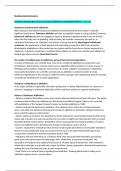Summary
Summary all articles risk behavior and addiction
- Course
- Institution
Extensive summary of all articles including: - A General Introduction to the Concept of Addiction and Addictive Effects - Sussman - Addiction, adolescence, and the integration of control and motivation - Gladwin - Cannabis use and the mental health of young people - Wayne D. Hall - Understand...
[Show more]



